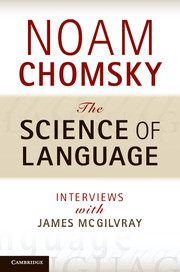Book contents
- Frontmatter
- Contents
- Introduction
- Part I The science of language and mind
- 1 Language, function, communication: language and the use of language
- 2 On a formal theory of language and its accommodation to biology; the distinctive nature of human concepts
- 3 Representation and computation
- 4 More on human concepts
- 5 Reflections on the study of language
- 6 Parameters, canalization, innateness, Universal Grammar
- 7 Development, master/control genes, etc.
- 8 Perfection and design (interview 20 January 2009)
- 9 Universal Grammar and simplicity
- 10 On the intellectual ailments of some scientists
- 11 The place of language in the mind
- 12 Chomsky's intellectual contributions
- 13 Simplicity and its role in Chomsky's work
- 14 Chomsky and Nelson Goodman
- Part II Human nature and its study
- Appendices
- Commentaries
- Glossary
- Bibliography
- Index
1 - Language, function, communication: language and the use of language
from Part I - The science of language and mind
Published online by Cambridge University Press: 05 June 2012
- Frontmatter
- Contents
- Introduction
- Part I The science of language and mind
- 1 Language, function, communication: language and the use of language
- 2 On a formal theory of language and its accommodation to biology; the distinctive nature of human concepts
- 3 Representation and computation
- 4 More on human concepts
- 5 Reflections on the study of language
- 6 Parameters, canalization, innateness, Universal Grammar
- 7 Development, master/control genes, etc.
- 8 Perfection and design (interview 20 January 2009)
- 9 Universal Grammar and simplicity
- 10 On the intellectual ailments of some scientists
- 11 The place of language in the mind
- 12 Chomsky's intellectual contributions
- 13 Simplicity and its role in Chomsky's work
- 14 Chomsky and Nelson Goodman
- Part II Human nature and its study
- Appendices
- Commentaries
- Glossary
- Bibliography
- Index
Summary
JM: I'll begin with a question that concerns the nature of language and the functions that language serves.
It is clear that language is central to human nature: it is likely to be the one thing that makes us distinctive. You think of language as biologically based, and so innate – built into our genomes in such a way that it appears automatically during a normal child's growth. And you acknowledge that language is a very useful cognitive tool that can serve many roles and that has given humans extraordinary cognitive advantages, compared to other creatures. But you resist the idea that language evolved because it improved the human capacity to communicate. Further, you're against the idea that language is some kind of social invention, an institution that was put together by us to help us serve our needs, and transmitted to the young by some kind of training or social inculcation. Could you explain why you hold these views?
NC: First of all, let's begin with the notion of function. That's not a clear biological notion or a psychological notion. So, for example, if I ask you what the function of the skeleton is, and you say: “the skeleton is to keep you straight and keep you from falling on the ground,” that is not false. But that also applies to its function to store calcium or to produce blood cells, or to do any of the other things it does. In fact, why the skeleton? Why do you even pick out the skeleton? We try to look at the organism from a certain point of view in order to build up a full understanding of it from the understanding of its components. But those components do all kinds of things; and what their function is depends on what you happen to be interested in. The usual sort of offhand way in which people identify the particular function of some system is the way in which it is ordinarily used, or its ‘most fundamental’ use, so that for the skeleton example, somehow, something else could store the calcium, and the skeleton would still be needed to keep the body together; so that's its function.[C]
- Type
- Chapter
- Information
- The Science of LanguageInterviews with James McGilvray, pp. 11 - 20Publisher: Cambridge University PressPrint publication year: 2012

